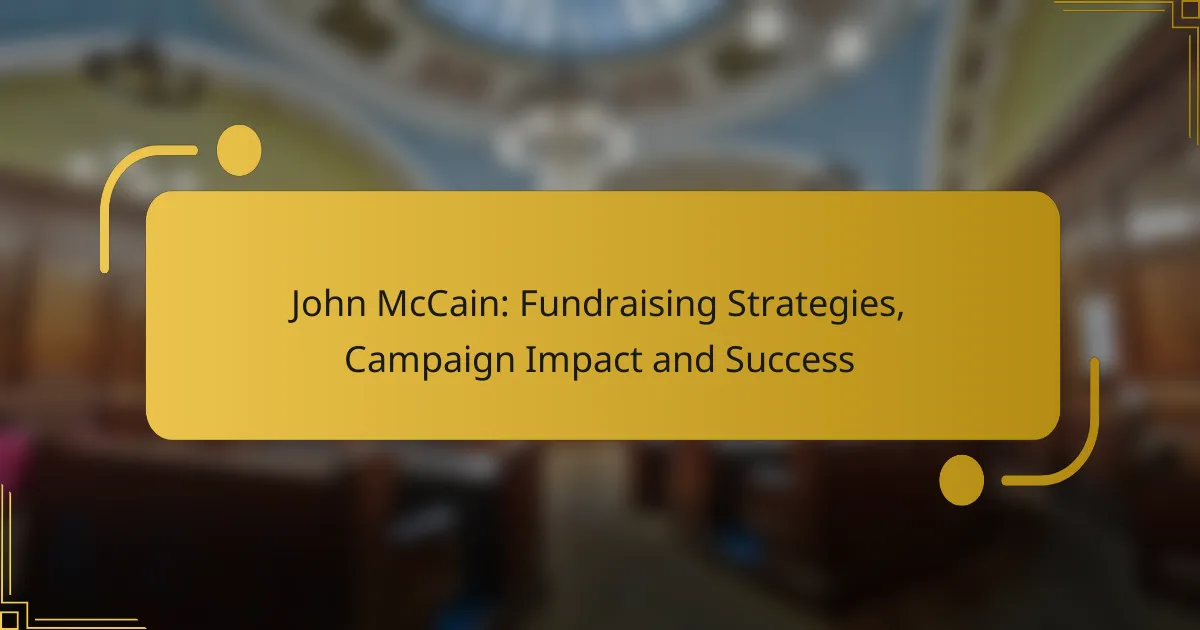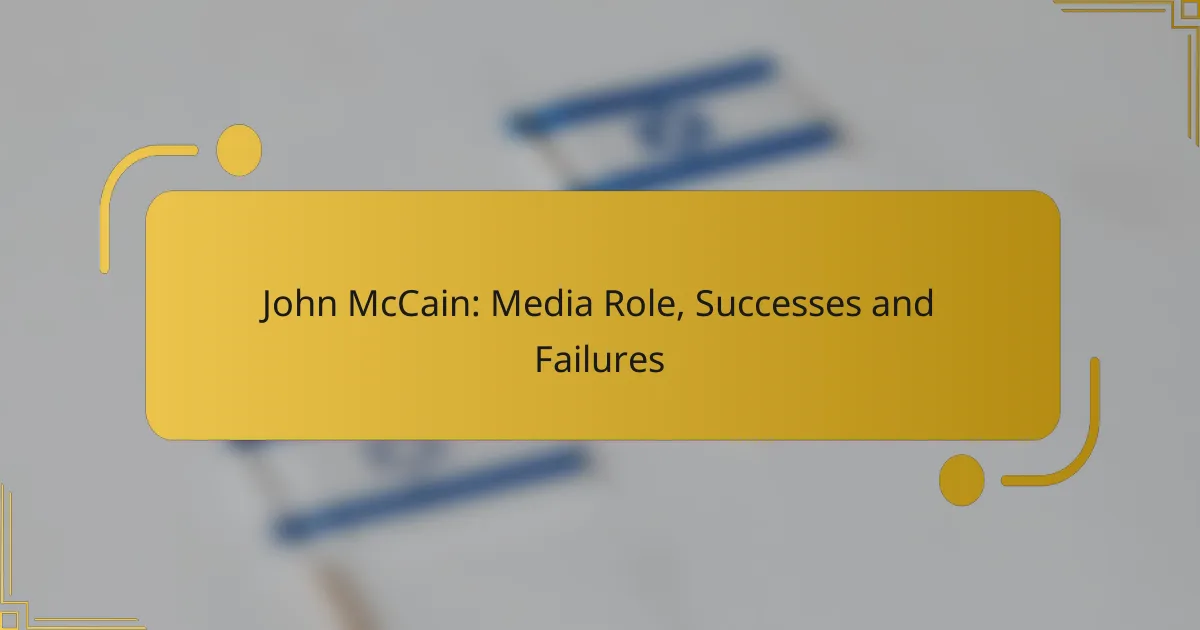John McCain’s campaigns were marked by innovative fundraising strategies that included grassroots initiatives, online engagement, and high-profile events, enabling him to reach a wide array of supporters. This robust financial backing was instrumental in amplifying his message and enhancing his competitiveness against opponents, while his consistent messaging and targeted outreach further defined his electoral impact.

What fundraising strategies did John McCain use in his campaigns?
John McCain employed a diverse range of fundraising strategies throughout his campaigns, focusing on grassroots efforts, online platforms, and high-profile events. These methods allowed him to connect with a broad base of supporters while also engaging major donors and political action committees (PACs).
Grassroots fundraising efforts
McCain’s grassroots fundraising efforts were pivotal in mobilizing small donations from a large number of supporters. He often emphasized personal connections, encouraging volunteers to reach out to their networks, which helped create a sense of community and shared purpose.
By leveraging social media and local events, McCain was able to tap into the enthusiasm of his base, resulting in significant contributions from individuals who felt personally invested in his campaign. This approach not only raised funds but also increased voter engagement.
Online donation platforms
Online donation platforms played a crucial role in McCain’s fundraising strategy, allowing supporters to contribute easily and quickly. His campaign utilized websites that facilitated secure transactions, making it convenient for donors to give from anywhere at any time.
By integrating social media with online fundraising, McCain’s team effectively reached younger voters and tech-savvy individuals, broadening his donor base. This strategy also included email campaigns that encouraged supporters to donate with a simple click.
High-profile fundraising events
High-profile fundraising events were essential for McCain to attract larger contributions from influential donors. These events often featured notable speakers and provided a platform for networking among supporters and potential contributors.
Such gatherings not only raised substantial funds but also enhanced McCain’s visibility among key political figures and business leaders, reinforcing his campaign’s credibility and appeal.
Major donor engagement
Engaging major donors was a strategic focus for McCain, as large contributions could significantly impact campaign resources. His team cultivated relationships with wealthy individuals and organizations, often providing them with exclusive access to campaign events and insights.
By maintaining open lines of communication and demonstrating the importance of their support, McCain’s campaign was able to secure substantial financial backing from these key stakeholders.
Utilization of PACs
McCain’s campaign effectively utilized political action committees (PACs) to amplify fundraising efforts. PACs allowed him to gather funds from like-minded individuals and organizations, pooling resources for greater impact.
By aligning with PACs that shared his values and policy goals, McCain was able to enhance his campaign’s financial strength while also benefiting from the networks and influence these committees provided.
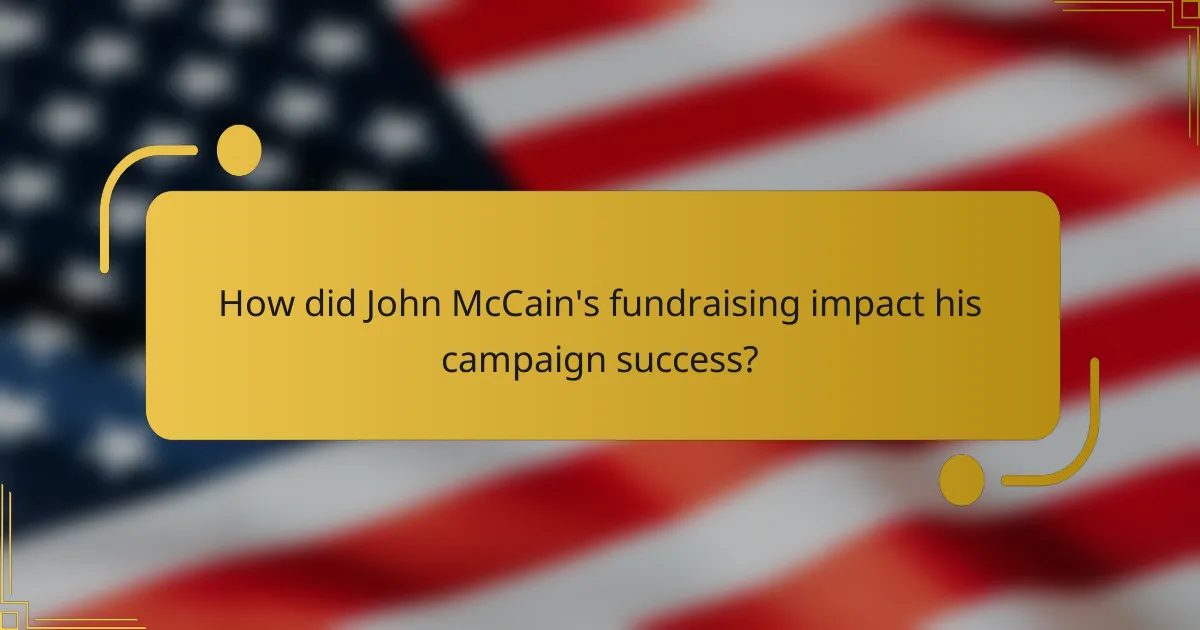
How did John McCain’s fundraising impact his campaign success?
John McCain’s fundraising significantly influenced his campaign success by providing the necessary resources for extensive outreach and engagement. Effective fundraising allowed him to amplify his message and compete more vigorously against his opponents.
Increased visibility and outreach
Fundraising enabled McCain to increase his visibility through advertisements, events, and grassroots campaigns. With a robust financial backing, his campaign could afford to reach a wider audience across various media platforms, enhancing public awareness of his candidacy.
For instance, substantial funds were allocated to television and online ads, which are crucial in modern campaigns. This visibility often translates to higher name recognition, which is vital in a crowded electoral field.
Enhanced voter engagement
With increased funds, McCain’s campaign could invest in voter engagement initiatives, such as town halls and community events. These interactions allowed him to connect directly with constituents, addressing their concerns and building rapport.
Effective voter engagement strategies included door-to-door canvassing and phone banking, which were supported by financial resources. Engaging voters personally often leads to higher turnout rates, which is essential for electoral success.
Ability to compete against opponents
McCain’s fundraising efforts provided him with the means to compete against opponents who may have had more established financial networks. This financial capability allowed him to match or exceed the spending of rivals, ensuring his campaign remained competitive.
Moreover, having a strong fundraising base can attract endorsements and support from influential donors, further bolstering a candidate’s position. This competitive edge is crucial in tight races where every dollar can make a significant difference.

What were the key factors in John McCain’s campaign strategies?
John McCain’s campaign strategies were shaped by a combination of message consistency, effective media relations, and targeted voter demographics. These elements played a crucial role in defining his approach and overall impact during elections.
Message consistency
Message consistency was vital for McCain’s campaigns, as it helped establish a clear identity and set expectations among voters. By maintaining a steady narrative focused on themes like integrity, experience, and national security, he reinforced his brand as a trustworthy candidate.
To achieve message consistency, campaigns should regularly communicate core values across all platforms, including speeches, advertisements, and social media. This approach ensures that voters receive a unified message, enhancing recognition and recall.
Media relations
McCain’s ability to cultivate strong media relations significantly influenced his campaign’s visibility and narrative. By engaging with journalists and participating in interviews, he was able to shape public perception and address key issues directly.
Effective media relations involve transparency and accessibility. Candidates should prioritize building relationships with reporters, providing timely information, and responding to inquiries promptly. This openness can lead to more favorable coverage and a stronger connection with the electorate.
Voter demographics targeting
Targeting specific voter demographics was a strategic priority for McCain, allowing him to tailor his messages to resonate with different groups. By analyzing data on age, gender, and political affiliation, his campaign could focus resources on key segments that were likely to support him.
To effectively target demographics, campaigns should utilize data analytics to identify trends and preferences among voters. Creating tailored outreach strategies, such as localized events or targeted advertisements, can enhance engagement and increase voter turnout.
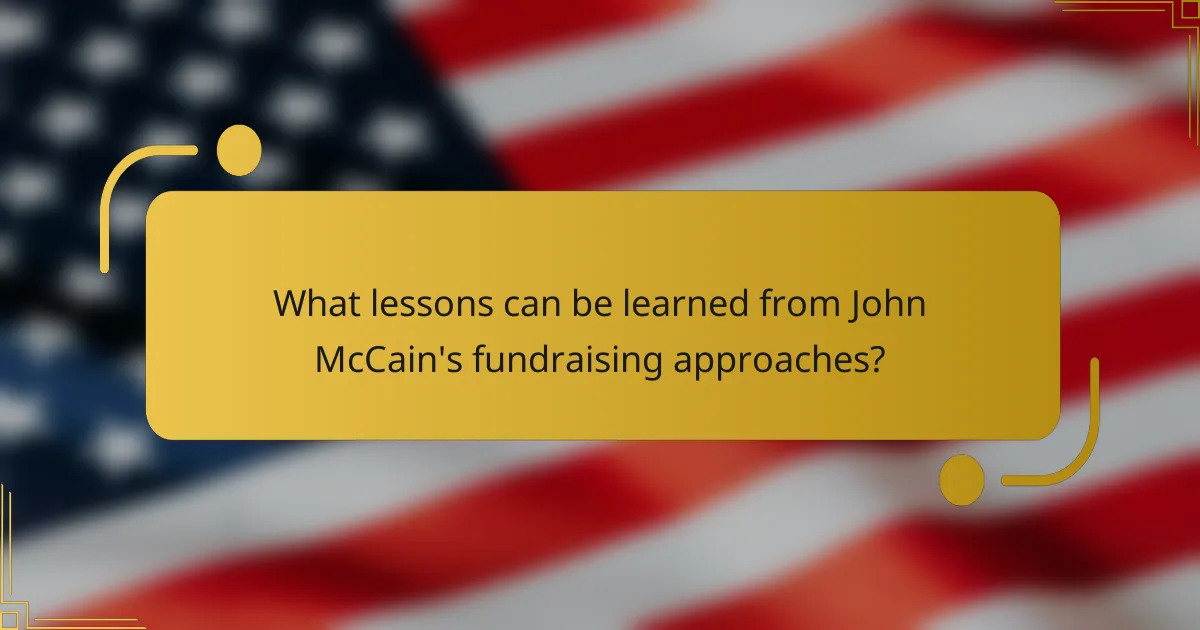
What lessons can be learned from John McCain’s fundraising approaches?
John McCain’s fundraising strategies highlight the importance of adaptability and innovation in political campaigns. His ability to engage a wide array of funding sources and utilize modern technology offers valuable insights for future candidates.
Importance of diverse funding sources
Diverse funding sources are crucial for a robust campaign. Relying on a single type of donor can lead to vulnerabilities, especially if that source dries up. McCain successfully tapped into individual contributions, political action committees (PACs), and grassroots donations, ensuring a steady flow of funds.
Campaigns should aim to cultivate a mix of large donors and small contributions. This approach not only broadens the financial base but also enhances community engagement and support. For instance, a campaign could target local businesses, online crowdfunding, and traditional fundraising events to maximize reach.
Leveraging social media for donations
Social media played a pivotal role in McCain’s fundraising efforts, allowing him to connect with a younger audience. Platforms like Facebook and Twitter enabled him to share his message widely and solicit donations directly from supporters.
To effectively leverage social media, campaigns should create compelling content that encourages sharing and engagement. Regular updates, behind-the-scenes glimpses, and interactive posts can foster a sense of community and prompt followers to contribute financially. Setting up donation buttons on social media profiles can streamline the giving process.
Building a strong donor network
A strong donor network is essential for sustained fundraising success. McCain focused on building relationships with his supporters, which helped him secure repeat donations and referrals. Personal outreach and appreciation can turn one-time donors into long-term allies.
Campaigns should prioritize donor engagement through regular communication, updates on campaign progress, and invitations to exclusive events. Establishing a tiered donor recognition program can also incentivize larger contributions while making all donors feel valued. This approach fosters loyalty and encourages a culture of giving within the campaign’s supporter base.
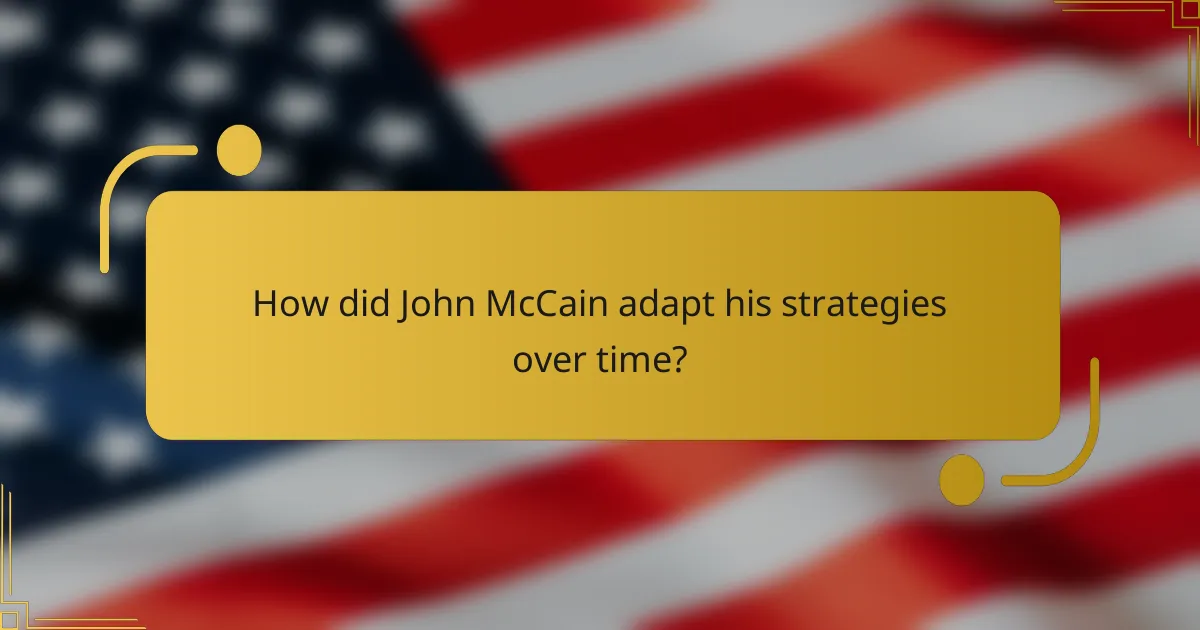
How did John McCain adapt his strategies over time?
John McCain adapted his fundraising strategies by responding to shifts in political climates and embracing new digital trends. This flexibility allowed him to maintain strong support and effectively mobilize resources throughout his campaigns.
Response to changing political climates
McCain’s ability to respond to changing political climates was crucial for his fundraising success. He adjusted his messaging and outreach efforts based on the prevailing sentiments of voters, particularly during pivotal elections. For instance, during the 2008 presidential campaign, he focused on themes of bipartisanship and national security, resonating with a diverse electorate.
To effectively navigate these changes, McCain often engaged with key stakeholders and adjusted his campaign strategies accordingly. This included forming alliances with influential groups and adapting his fundraising appeals to align with current issues, such as the economy or foreign policy challenges.
Adapting to digital fundraising trends
As digital fundraising became increasingly important, McCain embraced online platforms to reach potential donors. He utilized social media and email campaigns to engage supporters, allowing for more personalized communication and broader outreach. This shift enabled him to tap into younger demographics who preferred online interactions.
McCain’s campaigns often featured targeted online ads and fundraising events that leveraged digital tools. By integrating traditional fundraising methods with innovative digital strategies, he was able to enhance donor engagement and increase contributions significantly. Campaigns should consider adopting similar approaches to maximize their fundraising potential in the evolving digital landscape.
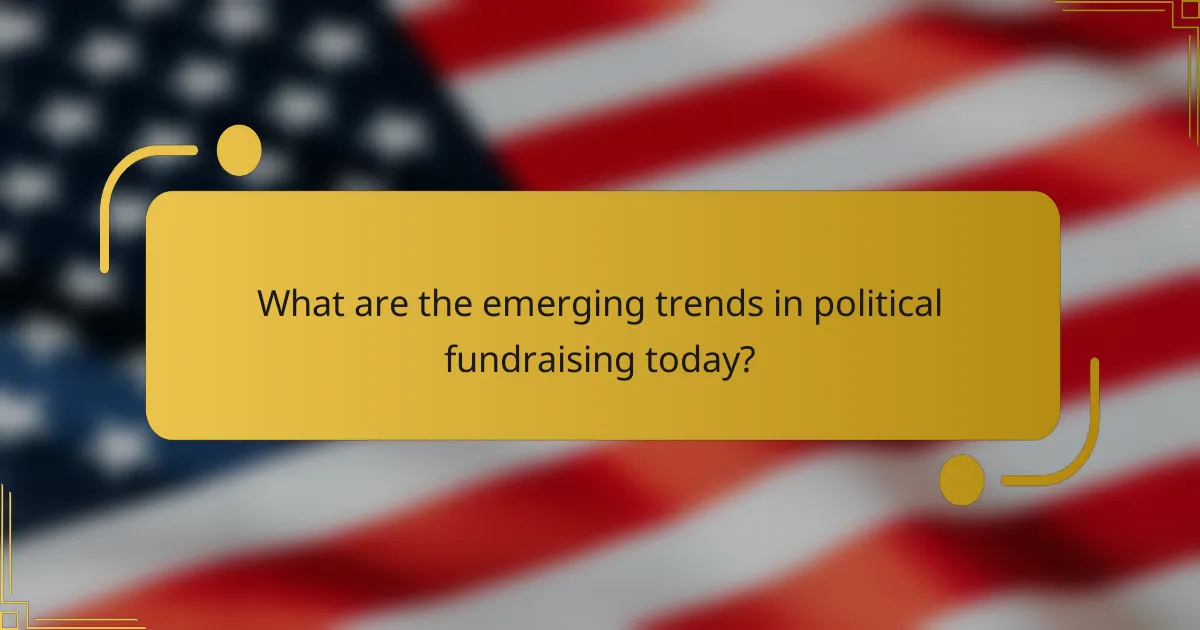
What are the emerging trends in political fundraising today?
Emerging trends in political fundraising today highlight a shift towards digital engagement and a growing emphasis on small-dollar donations. These strategies are reshaping how campaigns connect with supporters and raise funds, making it essential for candidates to adapt to the changing landscape.
Increased reliance on digital platforms
Political campaigns are increasingly utilizing digital platforms to reach potential donors. Social media, email campaigns, and crowdfunding sites allow candidates to engage with a broader audience at a lower cost compared to traditional fundraising methods.
For example, platforms like ActBlue and GoFundMe enable campaigns to collect donations quickly and efficiently. Candidates can leverage targeted ads on social media to reach specific demographics, maximizing their fundraising potential.
Focus on small-dollar donations
There is a notable trend towards soliciting small-dollar donations, which has become a cornerstone of many successful campaigns. This approach democratizes fundraising, allowing individuals to contribute without the need for large sums, thus broadening the donor base.
Campaigns often encourage supporters to give smaller amounts regularly, creating a steady stream of funding. Strategies such as matching donations during specific periods can further incentivize small contributions, enhancing overall fundraising efforts.
